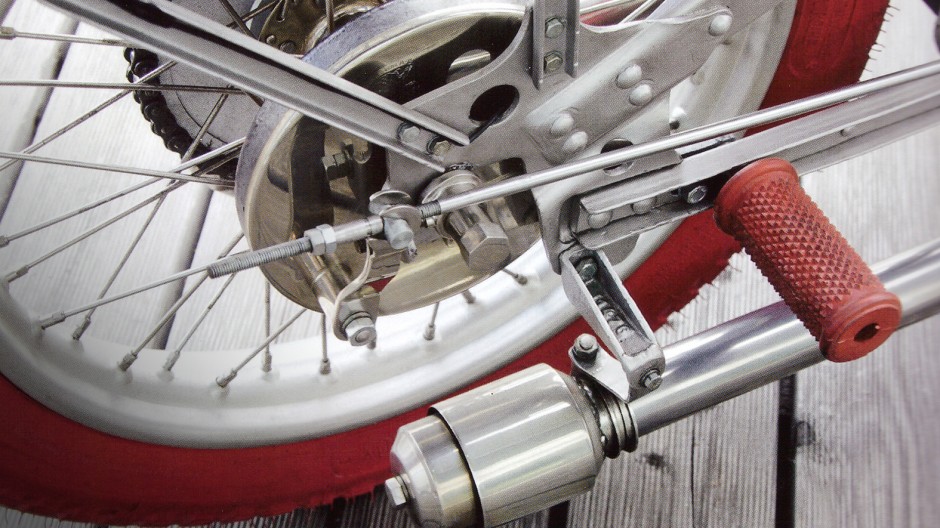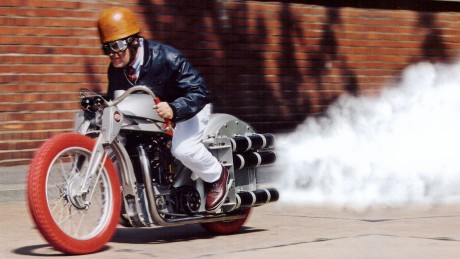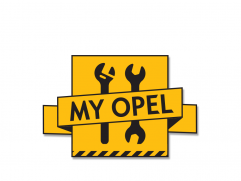
“You need to actually work on it yourself if you’re going to write about it.”
– Jürgen Nöll –
Book recommendation
144 pages, 280 photographs – Jürgen Nöll gives a retrospective account of a fascinating chapter in the company’s history in Opel Motorräder [‘Opel Motorcycles’] (published by Podszun Verlag). He presents some of the earliest motorcycles to feature straight twin engines, side-steered four-stroke engine bikes, inexpensive lightweight motorcycles, racing models, and the legendary Motoclub that still causes a stir at classic car meet-ups today.
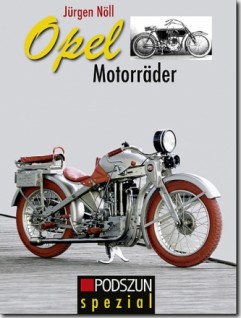
Just two visual details drew attention to Opel’s GT Concept a few weeks ago: the double exhaust pipes, alluding to the legendary Experimental GT from 1965, and the red tires.
Where did the red tires come from?
It wasn’t so clear which of the numerous Opel designs from the past the tires were alluding to. However, a retired former Opel employee, living in Rüsselsheim, immediately lit up when he saw the photo. He wrote an animated e-mail to his former colleagues still working at Opel, asking them to forward it to the company’s Communications Department.
THE MOST BEAUTIFUL MOTORCYCLE THAT OPEL EVER MADE
The recipients were not surprised to see who had written the e-mail. Who else could have correctly identified the origins of the bike’s striking visual elements? The retiree is no other than the Opel two-wheeler expert Jürgen Nöll. The red tires are a throwback to the Motoclub, which many experts claim is the most beautiful motorcycle Opel ever made.
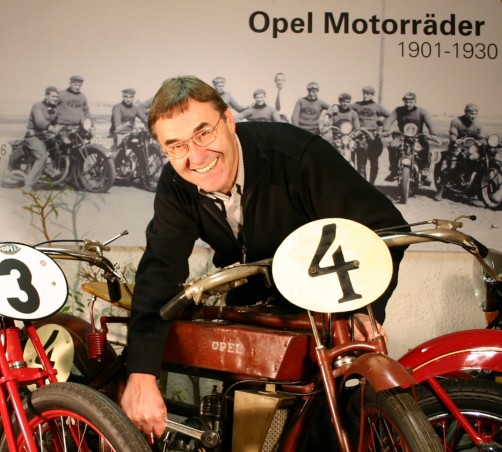
The mechanic in high spirits: Jürgen Nöll with a Bahnrennmaschine from 1923.
JUST A PIPE DREAM FOR MORE THAN HALF HIS LIFE
Mr. Nöll (66) worked in the Engine Development division at the International Development Center (ITEZ) until 2008. He wrote magazine articles and books in his free time, trying to keep the memories of Opel motorcycles alive among more than just nostalgic aficionados. He even restored some of the models himself, which he says goes without saying: “You need to actually work on it yourself if you’re going to write about it.” The Motoclub conjures up many special memories for him, as he dreamed of having one himself for over half of his life.
He has been an inveterate motorcycle enthusiast since he was 17 years old. He was once arrested by the police for driving an old NSU without a driver’s license. Fortunately, the case was dropped soon afterwards, due to the minor nature of the offence. The new Opel employee would go onto pursue a degree in mechanical engineering after completing his mechanic’s apprenticeship. And from then onwards, nothing would stop him – juridical or otherwise – from further galvanizing his passion for motorcycles.
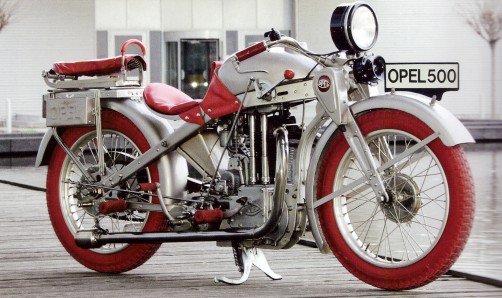
Truly iconic designs are timeless: The Motoclub 500 is still perceived as the apex of bold technology and style today.
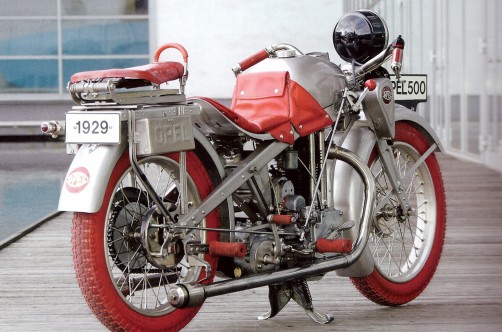
Take a seat: The club seat behind the gas tank is one of the bike’s many features adored by enthusiasts.

Bursts of red on silver: The Opel insignia near the seat and handles, surrounded by red.

Another special feature: It looks like a hand grenade, but it’s actually a muffler.
Motoclub
Was the Final Act
Before the Curtain Fell
Save the best for last – in retrospect, the history of Opel’s motorcycle production seems predicated on this principle. The first motorized two-wheeler was made in Rüsselsheim back in 1901. Many other models followed suit until 1907, dazzling customers and competitors alike with their innovative technical solutions. Production recommenced after the end of World War I. Opel made its name in the market with inexpensive, lightweight motorcycles – including some racing models – which were especially successful in the early 1920s.
In 1928, Opel moved production to the Elite-Diamant plants, where the Motoclub also went into production. It wasn’t just the distinctive style that popularized the ‘red-and-silver bird.’ Opel had acquired the production license from artist and designer Ernst Neumann-Neander, who had created several design elements that had never been seen before: the new pressed steel frame that could house various built-in engines without needing modification, the club seat fitted behind the dome-shaped gas tank, and the gentle front-wheel spring suspension that ensured a more comfortable riding experience, for example.
General Motors discontinued production of Opel motorcycles in 1930 caving into the pressures of the Great Depression, although initial sales figures for the Motoclub had been very promising. The group had acquired the Rüsselsheim-based company the previous year. Opel presented a total of 20 motorcycle models between 1901 and 1930 but only built around 6,000 units.
DISCOVERING HIS PASSION FOR RESTORING OLD VEHICLES
Jürgen Nöll came across an article in a trade magazine by motorcycle journalist Michael Heise about ten years later, giving a thrilling account of how he restored a completely run-down BMW piece by piece until it was in tip-top condition. Nöll was so inspired by the report that he got himself a wrecked NSU and brought it back to life with the same level of devotion. This is when he truly discovered his passion for restoring old vehicles.
Nöll soon made a habit of regularly restoring two-wheelers and writing magazine articles about the process. However, he found himself being plagued by the same question: “But you work at Opel. Why don’t you have any Opel motorcycles?” This was an exasperating question, since the young engineer was well aware of his employer’s roaring past as a motorcycle manufacturer. “But it was virtually impossible to get your hands on one of those bikes back then,” he recalls.
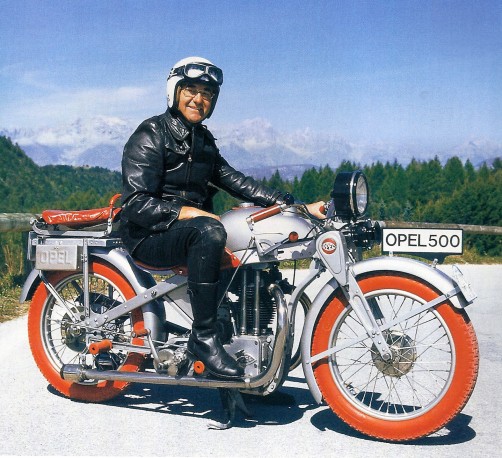
The legend, and the man to pass on its story: Jürgen Nöll and his Motoclub.
FATE COMES KNOCKING
The motorcycle enthusiast finally caught a break in 1986. When he came into work one morning, his colleagues immediately asked him if he’d already got hold of ‘her.’ When he asked what they meant, exactly, by ‘her,’ they showed him an article in the local newspaper. A man from Czechoslovakia had walked through the Opel main entrance the previous day wanting to sell an old Motoclub before eventually being turned away. Nöll jumped to his feet and picked up the phone. He learned that the seller had been told to try the museum in Sinsheim – and that he had stayed overnight in Rüsselsheim. Nöll managed to catch him just before he left.
“He wanted to sell the bike because he was planning to emigrate to the U.S.,” Nöll says. “I have no idea how he made it across the border from Czechoslovakia with a Motoclub in an open trailer. The vintage bike was considered a cultural asset in the country and you weren’t allowed to take it overseas.” But none of this mattered to Nöll in that moment. He paid the asking price and finally became an owner of an Opel motorcycle.
THE LEGEND MUST BE SILVER
The motorcycle took up all of his attention. The previous owner had painted it bright yellow. In addition to making it safe to ride on, as Nöll is a perfectionist, he also wanted to restore its classic look, the way it is remembered in the hearts and minds of all motorcycle enthusiasts: silver with a red seat and red tires.
“The original wasn’t painted at all, but coated with cadmium, which was a problem,” Nöll says, because cadmium coating was banned in the 1980s. So Nöll proceeded by mixing a paint color that was as close to the original as possible. “It couldn’t be a metallic silver. It needed to have a hint of bronze.” Future Motoclub restorers would no longer need to make a mix themselves, thanks to Opel: “We introduced a new color for the Ascona called Rembrandt Silver, which I’ve been recommending to everyone who’s restoring a Motoclub ever since.”
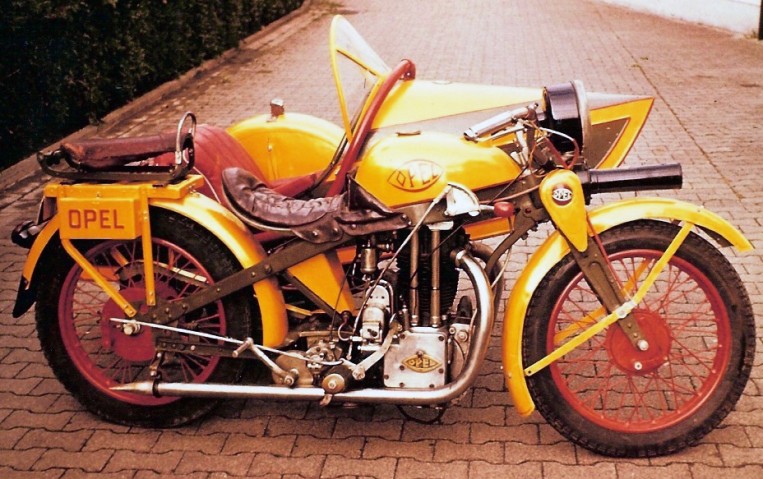
Not a great look in yellow: This is how the Motoclub looked when Jürgen Nöll purchased it in 1986.
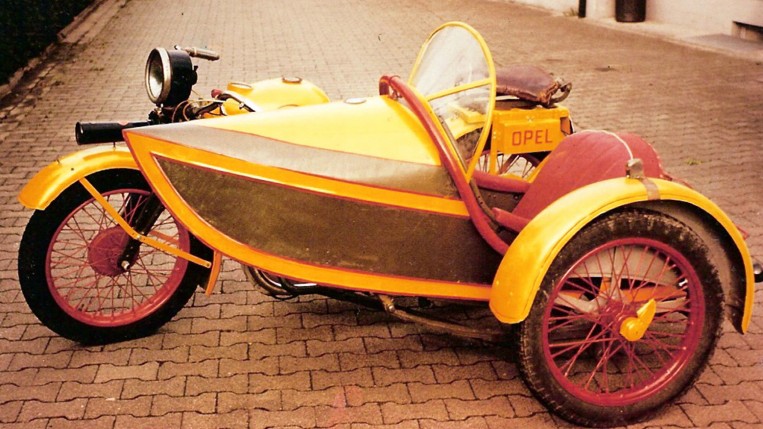
Though eye-catching, the sidecar doesn’t go quite so well with a Motoclub.

A truly rare model: An Opel motor-paced racing bike with a four-cylinder engine from the 1920s. It was used in bicycle races, where it would pull cyclists at record speeds.
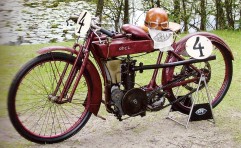
Not for the streets, but a classic nonetheless: the Bahnrennmaschine from 1923.
TIRELESS PURSUIT: CIRCLE OF FRIENDS FINANCE TIRE PRODUCTION
People have been coming to him for advice ever since. Jürgen Nöll has been an Opel motorcycle advisor for the vintage vehicle association as well as the vintage Opel association for many years, and is constantly sought after for his expert advice. Among the vintage vehicle aficionados, fans of the Motoclub in particular became a close-knit circle of friends who excitedly share and exchange tips and spare parts. This in turn made it possible to revive the second eye-catching element of the Motoclub – the red tires – even though they haven’t been available for many years.
One of the vintage Opel enthusiasts finally came across a company in Munich that was willing to produce red tires in the required dimensions. However, there was one condition: 100 pairs needed to be purchased, otherwise the order wouldn’t be financially worth it for the company. “Our friend had to make an advance payment of 50,000 German marks,” says Nöll. But he never regretted the investment. Since then, the stock has been completely sold off to the point where the owner of the last few units will only give them away in exchange for objects that he truly finds worthwhile.
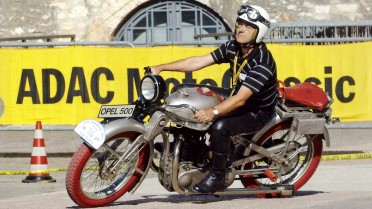
Motoclub forever: Jürgen Nöll 30 years ago – on his dream motorcycle.
AVAILABLE AGAIN: THE STORY OF OPEL MOTORCYCLES
Since then, several Motoclubs can be seen roaming across Germany and neighboring countries, donning almost exactly the same look as the original model from the late 1920s. Of course, Jürgen Nöll has made a name for himself many other times as a restorer of vintage Opels. For example, he restored a Bahnrennmaschine from 1922 for the company, which even required him to apply for a trading license. But that’s another story for another time.
